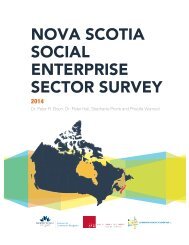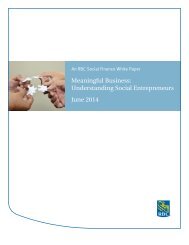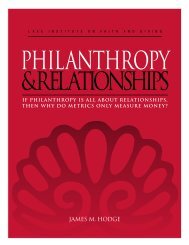Accelerating our Impact: Philanthropy, Innovation and Social Change
Create successful ePaper yourself
Turn your PDF publications into a flip-book with our unique Google optimized e-Paper software.
<strong>Accelerating</strong> <strong>our</strong> <strong>Impact</strong>: <strong>Philanthropy</strong>, <strong>Innovation</strong> <strong>and</strong> <strong>Social</strong> <strong>Change</strong> The J.W. McConnell Family Foundation<br />
The McConnell Foundation’s mission is to fund “initiatives of national significance<br />
which address challenges for Canadian society by engaging people, by building<br />
resilient communities, <strong>and</strong> by developing a strong knowledge base for the work that<br />
the Foundation supports.” With a small program staff based in Montreal, the<br />
Foundation could not expect to have detailed knowledge about what is going on in<br />
communities across the country. Instead, we developed a strategy to pursue <strong>our</strong><br />
goals that we termed Applied Dissemination (AD). By this we meant that in addition<br />
to supporting innovators to disseminate information about new programs, processes,<br />
knowledge, skills or concepts, we would also help them to work with communities<br />
<strong>and</strong> organizations to apply or adapt these innovations in different settings.<br />
Over the past decade, the Foundation has helped dozens of organizations to share a wide<br />
range of promising social innovations with interested communities across Canada. They<br />
have included teaching the skills of empathy to young children in order to reduce school<br />
bullying 2 , creating social networks for people with disabilities 3 , <strong>and</strong> tracking the “Vital<br />
Signs” 4 of a community as it measures its social, economic <strong>and</strong> environmental progress.<br />
Some rich learning has emerged from <strong>our</strong> Applied Dissemination approach about the<br />
process of spreading programs <strong>and</strong> ideas. 5 One important lesson is that the res<strong>our</strong>ces<br />
we initially developed, such as <strong>our</strong> 1998 primer Should you sow what you know? 6 , did<br />
not pay enough attention to the complexities involved in achieving lasting impact. We<br />
seriously underestimated the time <strong>and</strong> the skills required to move from a successful<br />
pilot to wide-spread implementation. After close to ten years, we have a much better<br />
appreciation of the contextual, operational, <strong>and</strong> organizational issues that are directly<br />
correlated with the ability to effect change.<br />
Such complexity can contribute to uncertainty: without knowing which specific<br />
strategies will in practice be most effective, many innovative organizations make<br />
an educated guess about their potential reach. This is not a fault. In many cases,<br />
clear intentions <strong>and</strong> commitments can serve as a stable platform on which to plan a<br />
c<strong>our</strong>se of action. For example, one Foundation grantee, The Tamarack Institute for<br />
Community Engagement, develops comprehensive community initiatives to reduce<br />
poverty in Canadian cities. It has a specific goal (helping 40,000 households reduce<br />
their level of poverty) <strong>and</strong> a consistent framework, but the participating communities<br />
choose very different pathways to achieve results. 7<br />
Rather than a blueprint, organizations like Tamarack have a strategic intent, which<br />
gets fleshed out as they develop <strong>and</strong> execute. Since their intentions are clear, their<br />
plan can evolve coherently <strong>and</strong> in the right direction – provided they have established<br />
reasonable indicators to track their progress.<br />
Which strategy will have the greatest potential for maximum impact will depend<br />
upon a host of factors – such as the nature of the innovation, community receptivity,<br />
the institutional framework/system to be changed, <strong>and</strong> the disseminating organization’s<br />
own m<strong>and</strong>ate <strong>and</strong> res<strong>our</strong>ces.<br />
Typically, then many social innovators begin with the development <strong>and</strong> testing of<br />
an idea, for example a new approach to helping homeless youth. If it is sufficiently<br />
promising <strong>and</strong> fills a gap that others have not addressed, it is likely to attract<br />
attention. Other communities seek information on the model, the initiating organization<br />
responds, <strong>and</strong> Applied Dissemination begins.<br />
At the same time, many of the organizations we supported have run up against the<br />
limits of growth alone in achieving meaningful outcomes for the communities they<br />
serve. When the Foundation began supporting Applied Dissemination projects, we<br />
thought that AD was mainly about reaching larger numbers of people. We soon<br />
realized, however, that growth alone does not guarantee increased impact – but since<br />
impact is more difficult to measure than growth, the latter often becomes a proxy for<br />
the former. While growth has a role to play, it may be only one of several paths to<br />
getting results. In reality, a range of different strategies is usually required.<br />
But a single-minded focus on growth will inevitably run up against barriers, such as<br />
competition, political or institutional resistance to change, or lack of res<strong>our</strong>ces that<br />
affect the originator’s ability to sustain the innovation. At that point, many will turn<br />
their energy to finding long-term solutions. Their efforts may challenge existing systems<br />
<strong>and</strong> will almost certainly dem<strong>and</strong> new skills, relationships <strong>and</strong> mindsets –<br />
including those held by funders.<br />
10<br />
2 Roots of Empathy website < http:// www.rootsofempathy.org > .<br />
3 PLAN website < http://www.plan.ca > .<br />
4 Vital Signs Canada website < http:// www.vitalsignscanada.ca > .<br />
5 See for example “A Summary of Lessons from Applied Dissemination Grants” (September 2006)<br />
on the McConnell Foundation’s website < http://www.mcconnellfoundation.ca > .<br />
6 Available on the McConnell Foundation’s website.<br />
7 See the Tamarack website < http://www.vibrantcommunities.ca > . 11







